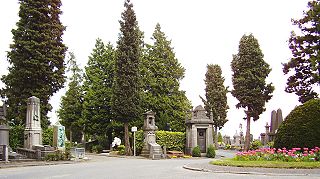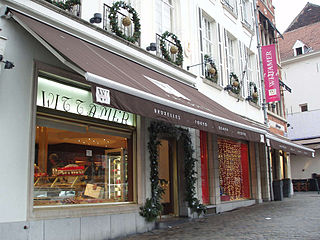
A chocolate bar or candy bar is a confection containing chocolate, which may also contain layerings or mixtures that include nuts, fruit, caramel, nougat, and wafers. A flat, easily breakable, chocolate bar is also called a tablet. In some varieties of English and food labeling standards, the term chocolate bar is reserved for bars of solid chocolate, with candy bar used for products with additional ingredients.

Belgian cuisine is widely varied with significant regional variations, while also reflecting the cuisines of neighbouring France, Germany and the Netherlands. It is sometimes said that Belgian food is served in the quantity of German cuisine but with the quality of French food. Outside the country, Belgium is best known for its chocolate, waffles, fries and beer.

A bonbon is a small chocolate confection. They are usually filled with liqueur or other sweet alcoholic ingredients, and sold wrapped in coloured foil.

Ixelles Cemetery, located in Ixelles in the southern part of Brussels, is one of the major cemeteries in Belgium. Ixelles Cemetery also refers to a neighbourhood with a lot of bars and restaurants for students, north of the actual cemetery. It is in fact located between the two main campuses of the Université libre de Bruxelles (ULB).

Quality Street is a line of tinned and boxed toffees, chocolates and sweets, first manufactured by Mackintosh's in Halifax, West Yorkshire, England, in 1936. It was named after J. M. Barrie's play Quality Street. Since 1988 they have been produced by Nestlé. Quality Street have long been a competitor to Cadbury Roses which were launched by Cadbury in 1938.

Leonidas is a registered trademark of the agri-food company Confiserie Leonidas S.A. The Belgian chocolate company was founded in 1913 by Leonidas Kestekides. The company is ISO 9001 and FSSC 22000 certified. As of 2019, the brand has more than 1,030 points of sale in 32 countries, the majority of which are franchises and around 40 are subsidiaries.

Cadbury Roses are a selection of machine wrapped chocolates made by Cadbury. Introduced in the UK in 1938, they were thought to be named after the English packaging equipment company "Rose Brothers" based in Gainsborough, Lincolnshire, that manufactured and supplied the machines that wrapped the chocolates.

The Royal Saint-Hubert Galleries is an ensemble of three glazed shopping arcades in central Brussels, Belgium. It consists of the Galerie du Roi or Koningsgalerij, the Galerie de la Reine or Koninginnegalerij and the Galerie des Princes or Prinsengalerij.

A chocolate truffle is a type of chocolate confectionery, traditionally made with a chocolate ganache centre coated in chocolate, cocoa powder, coconut, or chopped and toasted nuts, usually in a spherical, conical, or curved shape.

Côte d'Or is a producer of Belgian chocolate, owned by Mondelez International. Côte d'Or was founded in 1883 by Charles Neuhaus in Schaerbeek, Belgium, a chocolate manufacturer who used the name "Côte d'Or" referring to the old name of contemporary Ghana, the source of many of the cacao beans used in chocolate manufacturing.

Swiss chocolate is chocolate produced in Switzerland. While cacao beans and other ingredients such as sugar cane originate from outside Switzerland, the actual production of the chocolate must take place in Switzerland. Switzerland's chocolates have earned an international reputation for high quality with many famous international chocolate brands.

Cailler is a Swiss chocolate brand and production factory based in Broc. It was founded in Vevey by François-Louis Cailler in 1819 and remained independent until the early 20th century, when it associated with other producers. Shortly before, Cailler opened its main factory at Broc in 1898. The company was finally bought by Nestlé in 1929 and became a brand. Cailler is the oldest chocolate brand still in existence in Switzerland.

Guylian is a Belgian chocolate brand and manufacturer best known for its seashell shaped pralines. The company was founded in 1958 in Sint-Niklaas, Belgium by Guy Foubert and is now owned by the South Korean company Lotte Confectionery.

Belgian chocolate is chocolate produced in Belgium. A major industry since the 19th century, today it forms an important part of the nation's economy and culture.
Cavalier is a family-owned Belgian chocolate manufacturer founded in 1996, making only no-sugar-added chocolate products.

Wittamer & Co is a notable chocolatier based in Brussels, Belgium.

The merveilleux (marvelous) is a small cake that originated in France and is now found in Belgium and some U.S. cities. It consists of a sandwich of two light meringues welded with whipped cream which has been covered with whipped cream and dusted with chocolate shavings. A candied cherry sometimes decorates the cake.

Galler is a Belgian confectionery company, which has its head office in Vaux-sous-Chèvremont, a tiny village in the area of Liège. The company markets various products such as chocolate bars, slabs of chocolate, pralines, macarons, ice cream, and spreads. It also has a number of franchised boutiques under its brand.
Events in the year 1912 in Belgium.

Pralines, also known as Belgian chocolates, Belgian chocolate fondants or chocolate bonbons, are cases of chocolate filled with a soft centre. Jean Neuhaus II, a Belgian chocolatier, is generally credited for their introduction in 1912, although they were probably made since the 19th century.



















